您好,登錄后才能下訂單哦!
您好,登錄后才能下訂單哦!
這篇文章主要介紹Android如何實現懸浮窗效果,文中介紹的非常詳細,具有一定的參考價值,感興趣的小伙伴們一定要看完!
請看下圖:
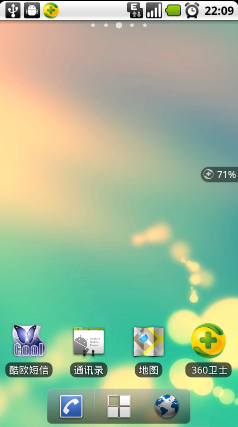
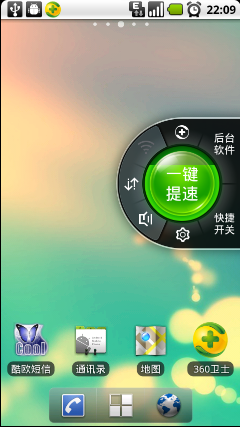
首先是一個小的懸浮窗顯示的是當前使用了百分之多少的內存,點擊一下小懸浮窗,就會彈出一個大的懸浮窗,可以一鍵加速。好,我們現在就來模擬實現一下類似的效果。
先談一下基本的實現原理,這種桌面懸浮窗的效果很類似與Widget,但是它比Widget要靈活的多。主要是通過WindowManager這個類來實現的,調用這個類的addView方法用于添加一個懸浮窗,updateViewLayout方法用于更新懸浮窗的參數,removeView用于移除懸浮窗。其中懸浮窗的參數有必要詳細說明一下。
WindowManager.LayoutParams這個類用于提供懸浮窗所需的參數,其中有幾個經常會用到的變量:
type值用于確定懸浮窗的類型,一般設為2002,表示在所有應用程序之上,但在狀態欄之下。
flags值用于確定懸浮窗的行為,比如說不可聚焦,非模態對話框等等,屬性非常多,大家可以查看文檔。
gravity值用于確定懸浮窗的對齊方式,一般設為左上角對齊,這樣當拖動懸浮窗的時候方便計算坐標。
x值用于確定懸浮窗的位置,如果要橫向移動懸浮窗,就需要改變這個值。
y值用于確定懸浮窗的位置,如果要縱向移動懸浮窗,就需要改變這個值。
width值用于指定懸浮窗的寬度。
height值用于指定懸浮窗的高度。
創建懸浮窗這種窗體需要向用戶申請權限才可以的,因此還需要在AndroidManifest.xml中加入
<uses-permission android:name="android.permission.SYSTEM_ALERT_WINDOW" />
原理介紹完了,下面我們開始用代碼實現。首先在Eclipse中新建一個Android項目,項目名就叫做360FloatWindowDemo。然后寫一下布局文件,布局文件非常簡單,只有一個按鈕,打開或新建activity_main.xml,
加入如下代碼:
<RelativeLayout xmlns:android="http://schemas.android.com/apk/res/android" xmlns:tools="http://schemas.android.com/tools" android:layout_width="fill_parent" android:layout_height="fill_parent" tools:context=".MainActivity" > <Button android:id="@+id/start_float_window" android:layout_width="fill_parent" android:layout_height="wrap_content" android:text="Start Float Window" > </Button> </RelativeLayout>
然后再新建一個名為float_window_small.xml的布局文件,用于做為小懸浮窗的布局,
在其中加入如下代碼:
<?xml version="1.0" encoding="UTF-8"?> <LinearLayout xmlns:android="http://schemas.android.com/apk/res/android" android:id="@+id/small_window_layout" android:layout_width="60dip" android:layout_height="25dip" android:background="@drawable/bg_small" > <TextView android:id="@+id/percent" android:layout_width="fill_parent" android:layout_height="fill_parent" android:gravity="center" android:textColor="#ffffff" /> </LinearLayout>
再新建一個名為float_window_big.xml的布局文件,用于做為大懸浮窗的布局,
在其中加入如下代碼:
<?xml version="1.0" encoding="UTF-8"?> <LinearLayout xmlns:android="http://schemas.android.com/apk/res/android" android:id="@+id/big_window_layout" android:layout_width="200dip" android:layout_height="100dip" android:background="@drawable/bg_big" android:orientation="vertical" > <Button android:id="@+id/close" android:layout_width="100dip" android:layout_height="40dip" android:layout_gravity="center_horizontal" android:layout_marginTop="12dip" android:text="關閉懸浮窗" /> <Button android:id="@+id/back" android:layout_width="100dip" android:layout_height="40dip" android:layout_gravity="center_horizontal" android:text="返回" /> </LinearLayout>
兩個懸浮窗布局文件中用到的圖片資源,大家可以隨便找點圖片來代替,同時我會給出源碼,大家也可以從源碼中取出。
然后打開或創建MainActivity,這是項目的主界面
在里面加入如下代碼:
public class MainActivity extends Activity {
@Override
protected void onCreate(Bundle savedInstanceState) {
super.onCreate(savedInstanceState);
setContentView(R.layout.activity_main);
Button startFloatWindow = (Button) findViewById(R.id.start_float_window);
startFloatWindow.setOnClickListener(new OnClickListener() {
@Override
public void onClick(View arg0) {
Intent intent = new Intent(MainActivity.this, FloatWindowService.class);
startService(intent);
finish();
}
});
}
}這里可以看到,MainActivity的代碼非窗簡單,就是對開啟懸浮窗的按鈕注冊了一個點擊事件,用于打開一個服務,然后關閉當前Activity。創建懸浮窗的邏輯都交給服務去做了。好,現在我們來創建這個服務。新建一個名為FloatWindowService的類,這個類繼承自Service
在里面加入如下代碼:
public class FloatWindowService extends Service {
/**
* 用于在線程中創建或移除懸浮窗。
*/
private Handler handler = new Handler();
/**
* 定時器,定時進行檢測當前應該創建還是移除懸浮窗。
*/
private Timer timer;
@Override
public IBinder onBind(Intent intent) {
return null;
}
@Override
public int onStartCommand(Intent intent, int flags, int startId) {
// 開啟定時器,每隔0.5秒刷新一次
if (timer == null) {
timer = new Timer();
timer.scheduleAtFixedRate(new RefreshTask(), 0, 500);
}
return super.onStartCommand(intent, flags, startId);
}
@Override
public void onDestroy() {
super.onDestroy();
// Service被終止的同時也停止定時器繼續運行
timer.cancel();
timer = null;
}
class RefreshTask extends TimerTask {
@Override
public void run() {
// 當前界面是桌面,且沒有懸浮窗顯示,則創建懸浮窗。
if (isHome() && !MyWindowManager.isWindowShowing()) {
handler.post(new Runnable() {
@Override
public void run() {
MyWindowManager.createSmallWindow(getApplicationContext());
}
});
}
// 當前界面不是桌面,且有懸浮窗顯示,則移除懸浮窗。
else if (!isHome() && MyWindowManager.isWindowShowing()) {
handler.post(new Runnable() {
@Override
public void run() {
MyWindowManager.removeSmallWindow(getApplicationContext());
MyWindowManager.removeBigWindow(getApplicationContext());
}
});
}
// 當前界面是桌面,且有懸浮窗顯示,則更新內存數據。
else if (isHome() && MyWindowManager.isWindowShowing()) {
handler.post(new Runnable() {
@Override
public void run() {
MyWindowManager.updateUsedPercent(getApplicationContext());
}
});
}
}
}
/**
* 判斷當前界面是否是桌面
*/
private boolean isHome() {
ActivityManager mActivityManager = (ActivityManager) getSystemService(Context.ACTIVITY_SERVICE);
List<RunningTaskInfo> rti = mActivityManager.getRunningTasks(1);
return getHomes().contains(rti.get(0).topActivity.getPackageName());
}
/**
* 獲得屬于桌面的應用的應用包名稱
*
* @return 返回包含所有包名的字符串列表
*/
private List<String> getHomes() {
List<String> names = new ArrayList<String>();
PackageManager packageManager = this.getPackageManager();
Intent intent = new Intent(Intent.ACTION_MAIN);
intent.addCategory(Intent.CATEGORY_HOME);
List<ResolveInfo> resolveInfo = packageManager.queryIntentActivities(intent,
PackageManager.MATCH_DEFAULT_ONLY);
for (ResolveInfo ri : resolveInfo) {
names.add(ri.activityInfo.packageName);
}
return names;
}
}FloatWindowService的onStartCommand方法中開啟了一個定時器,每隔500毫秒就會執行RefreshTask。在RefreshTask當中,要進行判斷,如果手機當前是在桌面的話,就應該顯示懸浮窗,如果手機打開了某一個應用程序,就應該移除懸浮窗,如果手機在桌面的話,還應該更新內存使用百分比的數據。而當FloatWindowService被銷毀的時候,應該將定時器停止,否則它還會一直運行。
從上面的代碼我們也可以看出,創建和移除懸浮窗,以及更新懸浮窗內的數據,都是由MyWindowManager這個類來管理的,比起直接把這些代碼寫在Activity或Service當中,使用一個專門的工具類來管理要好的多。不過要想創建懸浮窗,還是先要把懸浮窗的View寫出來。
新建一個名叫FloatWindowSmallView的類,繼承自LinearLayout。新建一個名叫FloatWindowBigView的類,也繼承自LinearLayout。
在FloatWindowSmallView中加入如下代碼:
public class FloatWindowSmallView extends LinearLayout {
/**
* 記錄小懸浮窗的寬度
*/
public static int viewWidth;
/**
* 記錄小懸浮窗的高度
*/
public static int viewHeight;
/**
* 記錄系統狀態欄的高度
*/
private static int statusBarHeight;
/**
* 用于更新小懸浮窗的位置
*/
private WindowManager windowManager;
/**
* 小懸浮窗的參數
*/
private WindowManager.LayoutParams mParams;
/**
* 記錄當前手指位置在屏幕上的橫坐標值
*/
private float xInScreen;
/**
* 記錄當前手指位置在屏幕上的縱坐標值
*/
private float yInScreen;
/**
* 記錄手指按下時在屏幕上的橫坐標的值
*/
private float xDownInScreen;
/**
* 記錄手指按下時在屏幕上的縱坐標的值
*/
private float yDownInScreen;
/**
* 記錄手指按下時在小懸浮窗的View上的橫坐標的值
*/
private float xInView;
/**
* 記錄手指按下時在小懸浮窗的View上的縱坐標的值
*/
private float yInView;
public FloatWindowSmallView(Context context) {
super(context);
windowManager = (WindowManager) context.getSystemService(Context.WINDOW_SERVICE);
LayoutInflater.from(context).inflate(R.layout.float_window_small, this);
View view = findViewById(R.id.small_window_layout);
viewWidth = view.getLayoutParams().width;
viewHeight = view.getLayoutParams().height;
TextView percentView = (TextView) findViewById(R.id.percent);
percentView.setText(MyWindowManager.getUsedPercentValue(context));
}
@Override
public boolean onTouchEvent(MotionEvent event) {
switch (event.getAction()) {
case MotionEvent.ACTION_DOWN:
// 手指按下時記錄必要數據,縱坐標的值都需要減去狀態欄高度
xInView = event.getX();
yInView = event.getY();
xDownInScreen = event.getRawX();
yDownInScreen = event.getRawY() - getStatusBarHeight();
xInScreen = event.getRawX();
yInScreen = event.getRawY() - getStatusBarHeight();
break;
case MotionEvent.ACTION_MOVE:
xInScreen = event.getRawX();
yInScreen = event.getRawY() - getStatusBarHeight();
// 手指移動的時候更新小懸浮窗的位置
updateViewPosition();
break;
case MotionEvent.ACTION_UP:
// 如果手指離開屏幕時,xDownInScreen和xInScreen相等,且yDownInScreen和yInScreen相等,則視為觸發了單擊事件。
if (xDownInScreen == xInScreen && yDownInScreen == yInScreen) {
openBigWindow();
}
break;
default:
break;
}
return true;
}
/**
* 將小懸浮窗的參數傳入,用于更新小懸浮窗的位置。
*
* @param params
* 小懸浮窗的參數
*/
public void setParams(WindowManager.LayoutParams params) {
mParams = params;
}
/**
* 更新小懸浮窗在屏幕中的位置。
*/
private void updateViewPosition() {
mParams.x = (int) (xInScreen - xInView);
mParams.y = (int) (yInScreen - yInView);
windowManager.updateViewLayout(this, mParams);
}
/**
* 打開大懸浮窗,同時關閉小懸浮窗。
*/
private void openBigWindow() {
MyWindowManager.createBigWindow(getContext());
MyWindowManager.removeSmallWindow(getContext());
}
/**
* 用于獲取狀態欄的高度。
*
* @return 返回狀態欄高度的像素值。
*/
private int getStatusBarHeight() {
if (statusBarHeight == 0) {
try {
Class<?> c = Class.forName("com.android.internal.R$dimen");
Object o = c.newInstance();
Field field = c.getField("status_bar_height");
int x = (Integer) field.get(o);
statusBarHeight = getResources().getDimensionPixelSize(x);
} catch (Exception e) {
e.printStackTrace();
}
}
return statusBarHeight;
}其中,對這個View的onTouchEvent事件進行了重寫,用于實現拖動和點擊的效果。如果發現用戶觸發了ACTION_DOWN事件,會記錄按下時的坐標等數據。如果發現用戶觸發了ACTION_MOVE事件,則根據當前移動的坐標更新懸浮窗在屏幕中的位置。如果發現用戶觸發了ACTION_UP事件,會和ACTION_DOWN中記下的坐標對比,如果發現是相同的,則視為用戶對懸浮窗進行了點擊。點擊小懸浮窗則打開大懸浮窗,然后我們來實現大懸浮窗的View。
在FloatWindowBigView中加入如下代碼:
public class FloatWindowBigView extends LinearLayout {
/**
* 記錄大懸浮窗的寬度
*/
public static int viewWidth;
/**
* 記錄大懸浮窗的高度
*/
public static int viewHeight;
public FloatWindowBigView(final Context context) {
super(context);
LayoutInflater.from(context).inflate(R.layout.float_window_big, this);
View view = findViewById(R.id.big_window_layout);
viewWidth = view.getLayoutParams().width;
viewHeight = view.getLayoutParams().height;
Button close = (Button) findViewById(R.id.close);
Button back = (Button) findViewById(R.id.back);
close.setOnClickListener(new OnClickListener() {
@Override
public void onClick(View v) {
// 點擊關閉懸浮窗的時候,移除所有懸浮窗,并停止Service
MyWindowManager.removeBigWindow(context);
MyWindowManager.removeSmallWindow(context);
Intent intent = new Intent(getContext(), FloatWindowService.class);
context.stopService(intent);
}
});
back.setOnClickListener(new OnClickListener() {
@Override
public void onClick(View v) {
// 點擊返回的時候,移除大懸浮窗,創建小懸浮窗
MyWindowManager.removeBigWindow(context);
MyWindowManager.createSmallWindow(context);
}
});
}
}比起FloatWindowSmallView,FloatWindowBigView要簡單的多,其中只有兩個按鈕,點擊close按鈕,將懸浮窗全部移除,并將Service終止。單擊back按鈕則移除大懸浮窗,重新創建小懸浮窗。
現在兩個懸浮窗的View都已經寫好了,我們來創建MyWindowManager,
代碼如下:
public class MyWindowManager {
/**
* 小懸浮窗View的實例
*/
private static FloatWindowSmallView smallWindow;
/**
* 大懸浮窗View的實例
*/
private static FloatWindowBigView bigWindow;
/**
* 小懸浮窗View的參數
*/
private static LayoutParams smallWindowParams;
/**
* 大懸浮窗View的參數
*/
private static LayoutParams bigWindowParams;
/**
* 用于控制在屏幕上添加或移除懸浮窗
*/
private static WindowManager mWindowManager;
/**
* 用于獲取手機可用內存
*/
private static ActivityManager mActivityManager;
/**
* 創建一個小懸浮窗。初始位置為屏幕的右部中間位置。
*
* @param context
* 必須為應用程序的Context.
*/
public static void createSmallWindow(Context context) {
WindowManager windowManager = getWindowManager(context);
int screenWidth = windowManager.getDefaultDisplay().getWidth();
int screenHeight = windowManager.getDefaultDisplay().getHeight();
if (smallWindow == null) {
smallWindow = new FloatWindowSmallView(context);
if (smallWindowParams == null) {
smallWindowParams = new LayoutParams();
smallWindowParams.type = LayoutParams.TYPE_PHONE;
smallWindowParams.format = PixelFormat.RGBA_8888;
smallWindowParams.flags = LayoutParams.FLAG_NOT_TOUCH_MODAL
| LayoutParams.FLAG_NOT_FOCUSABLE;
smallWindowParams.gravity = Gravity.LEFT | Gravity.TOP;
smallWindowParams.width = FloatWindowSmallView.viewWidth;
smallWindowParams.height = FloatWindowSmallView.viewHeight;
smallWindowParams.x = screenWidth;
smallWindowParams.y = screenHeight / 2;
}
smallWindow.setParams(smallWindowParams);
windowManager.addView(smallWindow, smallWindowParams);
}
}
/**
* 將小懸浮窗從屏幕上移除。
*
* @param context
* 必須為應用程序的Context.
*/
public static void removeSmallWindow(Context context) {
if (smallWindow != null) {
WindowManager windowManager = getWindowManager(context);
windowManager.removeView(smallWindow);
smallWindow = null;
}
}
/**
* 創建一個大懸浮窗。位置為屏幕正中間。
*
* @param context
* 必須為應用程序的Context.
*/
public static void createBigWindow(Context context) {
WindowManager windowManager = getWindowManager(context);
int screenWidth = windowManager.getDefaultDisplay().getWidth();
int screenHeight = windowManager.getDefaultDisplay().getHeight();
if (bigWindow == null) {
bigWindow = new FloatWindowBigView(context);
if (bigWindowParams == null) {
bigWindowParams = new LayoutParams();
bigWindowParams.x = screenWidth / 2 - FloatWindowBigView.viewWidth / 2;
bigWindowParams.y = screenHeight / 2 - FloatWindowBigView.viewHeight / 2;
bigWindowParams.type = LayoutParams.TYPE_PHONE;
bigWindowParams.format = PixelFormat.RGBA_8888;
bigWindowParams.gravity = Gravity.LEFT | Gravity.TOP;
bigWindowParams.width = FloatWindowBigView.viewWidth;
bigWindowParams.height = FloatWindowBigView.viewHeight;
}
windowManager.addView(bigWindow, bigWindowParams);
}
}
/**
* 將大懸浮窗從屏幕上移除。
*
* @param context
* 必須為應用程序的Context.
*/
public static void removeBigWindow(Context context) {
if (bigWindow != null) {
WindowManager windowManager = getWindowManager(context);
windowManager.removeView(bigWindow);
bigWindow = null;
}
}
/**
* 更新小懸浮窗的TextView上的數據,顯示內存使用的百分比。
*
* @param context
* 可傳入應用程序上下文。
*/
public static void updateUsedPercent(Context context) {
if (smallWindow != null) {
TextView percentView = (TextView) smallWindow.findViewById(R.id.percent);
percentView.setText(getUsedPercentValue(context));
}
}
/**
* 是否有懸浮窗(包括小懸浮窗和大懸浮窗)顯示在屏幕上。
*
* @return 有懸浮窗顯示在桌面上返回true,沒有的話返回false。
*/
public static boolean isWindowShowing() {
return smallWindow != null || bigWindow != null;
}
/**
* 如果WindowManager還未創建,則創建一個新的WindowManager返回。否則返回當前已創建的WindowManager。
*
* @param context
* 必須為應用程序的Context.
* @return WindowManager的實例,用于控制在屏幕上添加或移除懸浮窗。
*/
private static WindowManager getWindowManager(Context context) {
if (mWindowManager == null) {
mWindowManager = (WindowManager) context.getSystemService(Context.WINDOW_SERVICE);
}
return mWindowManager;
}
/**
* 如果ActivityManager還未創建,則創建一個新的ActivityManager返回。否則返回當前已創建的ActivityManager。
*
* @param context
* 可傳入應用程序上下文。
* @return ActivityManager的實例,用于獲取手機可用內存。
*/
private static ActivityManager getActivityManager(Context context) {
if (mActivityManager == null) {
mActivityManager = (ActivityManager) context.getSystemService(Context.ACTIVITY_SERVICE);
}
return mActivityManager;
}
/**
* 計算已使用內存的百分比,并返回。
*
* @param context
* 可傳入應用程序上下文。
* @return 已使用內存的百分比,以字符串形式返回。
*/
public static String getUsedPercentValue(Context context) {
String dir = "/proc/meminfo";
try {
FileReader fr = new FileReader(dir);
BufferedReader br = new BufferedReader(fr, 2048);
String memoryLine = br.readLine();
String subMemoryLine = memoryLine.substring(memoryLine.indexOf("MemTotal:"));
br.close();
long totalMemorySize = Integer.parseInt(subMemoryLine.replaceAll("\\D+", ""));
long availableSize = getAvailableMemory(context) / 1024;
int percent = (int) ((totalMemorySize - availableSize) / (float) totalMemorySize * 100);
return percent + "%";
} catch (IOException e) {
e.printStackTrace();
}
return "懸浮窗";
}
/**
* 獲取當前可用內存,返回數據以字節為單位。
*
* @param context
* 可傳入應用程序上下文。
* @return 當前可用內存。
*/
private static long getAvailableMemory(Context context) {
ActivityManager.MemoryInfo mi = new ActivityManager.MemoryInfo();
getActivityManager(context).getMemoryInfo(mi);
return mi.availMem;
}
}這個類負責了控制大懸浮窗,小懸浮窗的創建和移除,系統內存使用百分比的計算等操作。
到這里基本所有的代碼都已經寫完了,然后我們來看一下AndroidManifest.xml文件吧,
里面代碼如下:
<?xml version="1.0" encoding="utf-8"?> <manifest xmlns:android="http://schemas.android.com/apk/res/android" package="com.demo.floatwindowdemo" android:versionCode="1" android:versionName="1.0" > <uses-permission android:name="android.permission.SYSTEM_ALERT_WINDOW" /> <uses-sdk android:minSdkVersion="8" android:targetSdkVersion="8" /> <application android:allowBackup="true" android:icon="@drawable/ic_launcher" android:label="@string/app_name" android:theme="@style/AppTheme" > <activity android:name="com.demo.floatwindowdemo.MainActivity" android:label="@string/app_name" > <intent-filter> <action android:name="android.intent.action.MAIN" /> <category android:name="android.intent.category.LAUNCHER" /> </intent-filter> </activity> <service android:name=".FloatWindowService"></service> </application> </manifest>
比較簡單,記得把Activity和Service在里面注冊好,還有一個權限聲明需要添加的android.permission.SYSTEM_ALERT_WINDOW,表示需要用戶授權允許創建系統提示窗口,也就是我們的桌面懸浮窗。
好了,現在讓我們運行一下項目吧,效果如下圖,主界面只有一個簡單的按鈕,點擊按鈕后,Activity被關閉,小懸浮窗顯示在桌面上。其中顯示著當前內存使用的百分比。
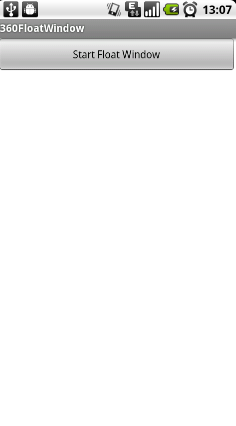
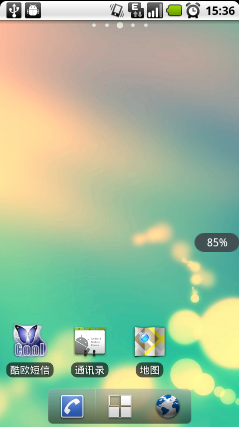
小懸浮窗是可以自由拖動的,如果打開了其它的應用程序,小懸浮窗會自動隱藏,回到桌面后小懸浮窗又會顯示出來。
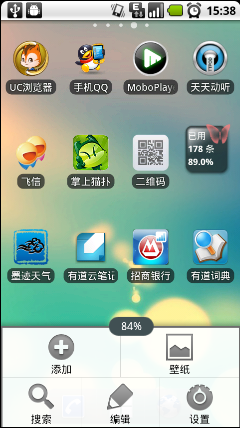
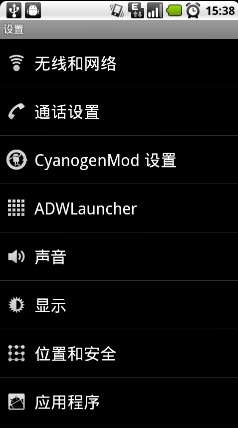
如果點擊了小懸浮窗會彈出大懸浮窗來,這里我們大懸浮窗做的比較簡單,就只有兩個按鈕。大懸浮窗展示的時候手機的所有其它程序是不可點的,因為焦點都在懸浮窗上了。點擊返回按鈕會重新展示小懸浮窗,點擊關閉懸浮窗按鈕,Service也會一起停掉。
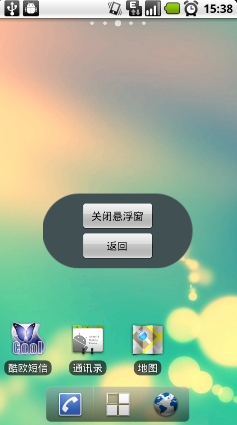
360手機衛士的一鍵加速功能我們就不做了,就像獨孤九劍一樣,重要的是劍意而不是劍招,我相信大家學會了創建懸浮窗的基本原理后可以做出比360更有創意的東西。
如果大家還有什么疑問,請在下面留言。
對桌面懸浮窗感興趣的朋友可以繼續閱讀 Android桌面懸浮窗進階,QQ手機管家小火箭效果實現 。
源碼下載,請點擊這里
補充:有朋友跟我反應,上面的代碼在Android 3.0以上的系統運行會崩潰,我看了一下,確實如此,主要是3.0之后想要獲取正在運行的任務,需要加上權限聲明。在AndroidManifest.xml中加入
<uses-permission android:name="android.permission.GET_TASKS" />
即可解決此問題。
以上是“Android如何實現懸浮窗效果”這篇文章的所有內容,感謝各位的閱讀!希望分享的內容對大家有幫助,更多相關知識,歡迎關注億速云行業資訊頻道!
免責聲明:本站發布的內容(圖片、視頻和文字)以原創、轉載和分享為主,文章觀點不代表本網站立場,如果涉及侵權請聯系站長郵箱:is@yisu.com進行舉報,并提供相關證據,一經查實,將立刻刪除涉嫌侵權內容。